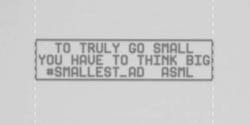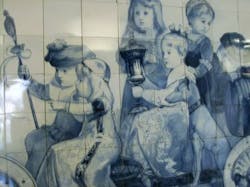
The Netherlands is a small and green country. When traveling there by train (which is most convenient), you see dairy farms and old towns with red brick houses. The Netherlands' size is less than a third of the state of New York. Still, it has a very strong photonics community with a few companies that even dominate world markets.
My reason for this journey is the Annual Meeting of the European Optical Society EOS in Delft. Different to the American optical societies, the EOS is a federation of regional societies with just a small central organization. The EOS holds a number of topical meetings and organizes its EOSAM conference, its largest event, every second year.
The conference was organized by Paul Urbach, a professor at the Technical University Delft, and his team. They were joined by co-chair Stefan Baeumer from TNO, an organization that I will introduce later.
Since Baeumer, a graduate from Technical University in Berlin, has made his career in The Netherlands, he well understands the local photonics community here. Stefan has been with Philips, the former Dutch electronics and photonics giant, for many years. "They have done a lot in the field of optics, but in recent years they shifted to other fields—mainly healthcare."
Focused on consumer products and healthcare, Philips employs about 74,000 people today. This is the direction where Philips moved to when profits for TV sets and mobile audio devices (remember the Walkman?) vanished. Philips Lighting, once the biggest lighting business in the world, was spun off and renamed as Signify BV just a few months ago. Today, the company looks quite successful and maintains strong optics competence, which distinguishes it from many competitors that sadly no longer exist.
Founded in 1984 and nurtured in the Philips ecosystem is the actual 'elephant in the room' here: ASML. "ASML sells German optics with Dutch precision mechanics," Baeumer explained to me. With large objectives from Carl Zeiss SMT (where they bought a €1 billion stake) and their own wafer stepper systems, they dominate the world lithography market. EUV is just taking off there. They hired 341 new people in September and plan to add 3000 new staff within one year, as an ASML official told me during EOSAM 2018.Asked for the future of EUV, Martin van den Brink, the CTO of ASML answered in a recent interview: "We know what we'll be doing for the next 10 years."
A strong and well-connected academic infrastructure
As I write this, I sit in the cafeteria of the Technical University Delft. Nice place with excellent coffee, comfy couches, and many wall sockets as I happily acknowledge. The Netherlands have an excellent academic infrastructure. The Technical Universitie Delft with its Department of Imaging Physics is just one photonics hotspot here. You may find others for photonic integration (Eindhoven), biomedical imaging (Rotterdam, Amsterdam) and many more. If you talk quantum, they have QuTech here, an advanced research center for quantum computing and quantum Internet, a collaboration founded by the Delft University of Technology and research institute TNO.Urbach, co-chair of the EOS conference and head of the Optics Research Group of TU Delft, is one of the researchers who work on the cutting edge of measurement technology for lithography systems. "Often, we are not really imaging—we are rather sensing and retrieving." This is how he uses methods such as computational imaging to push the resolution of optical imaging methods far beyond the classical resolution limits, while incorporating a priori knowledge.
For students, they want to offer bi-national tracks. The Universities in Jena (Germany) and Delft (Netherlands) plan to offer a common masters education on imaging and quantum technologies. "We did this without EU money," Urbach confesses with a smile. On board are the industry partners ASML and Carl Zeiss, plus Fraunhofer IOF in Jena and TNO in Delft.
Two years ago, the Dutch Optics Centre (DOC) has been founded here as an initiative of TNO and TU Delft. It became also an institute of TU Delft. It aims to stimulate applied optics research and to help Dutch optics industry with innovations in photonics. Besides defining research projects, in which academic optics groups and companies from all over the Netherlands participate, DOC helps in valorizing R&D results into projects with high technology readiness levels.
Now about TNO: located on the TU Delft campus, they are a 150-person organization that commercializes optomechatronic research results for industrial applications. Baeumer explains: "We are somehow like Fraunhofer, just with that special Dutch flavor." That is a small local organization with a global outreach—for instance, in the ELT project or several satellite missions.
Last but not least, I should say a few words about the conference here: EOSAM has traditionally close ties with optics industry and so this year’s program was again organized around core topics such as Optical systems design, tolerancing and manufacturing. Of course, the one-week program included much more than that: Tutorials, eight tracks, great plenaries, Student Prices, and sessions on challenges in photonics called "Controlling the energy density of light in 3D nanostructures" and "The dawn of quantum networks."
Whether this comes to light sooner or rather later, the next EOSAM meeting is certain and will be held in autumn 2020 in Porto, Portugal.
Related: "The secret of EUV generation" by Laser Focus World contributing editor Andreas Thoss
About the Author
Andreas Thoss
Contributing Editor, Germany
Andreas Thoss is the Managing Director of THOSS Media (Berlin) and has many years of experience in photonics-related research, publishing, marketing, and public relations. He worked with John Wiley & Sons until 2010, when he founded THOSS Media. In 2012, he founded the scientific journal Advanced Optical Technologies. His university research focused on ultrashort and ultra-intense laser pulses, and he holds several patents.


